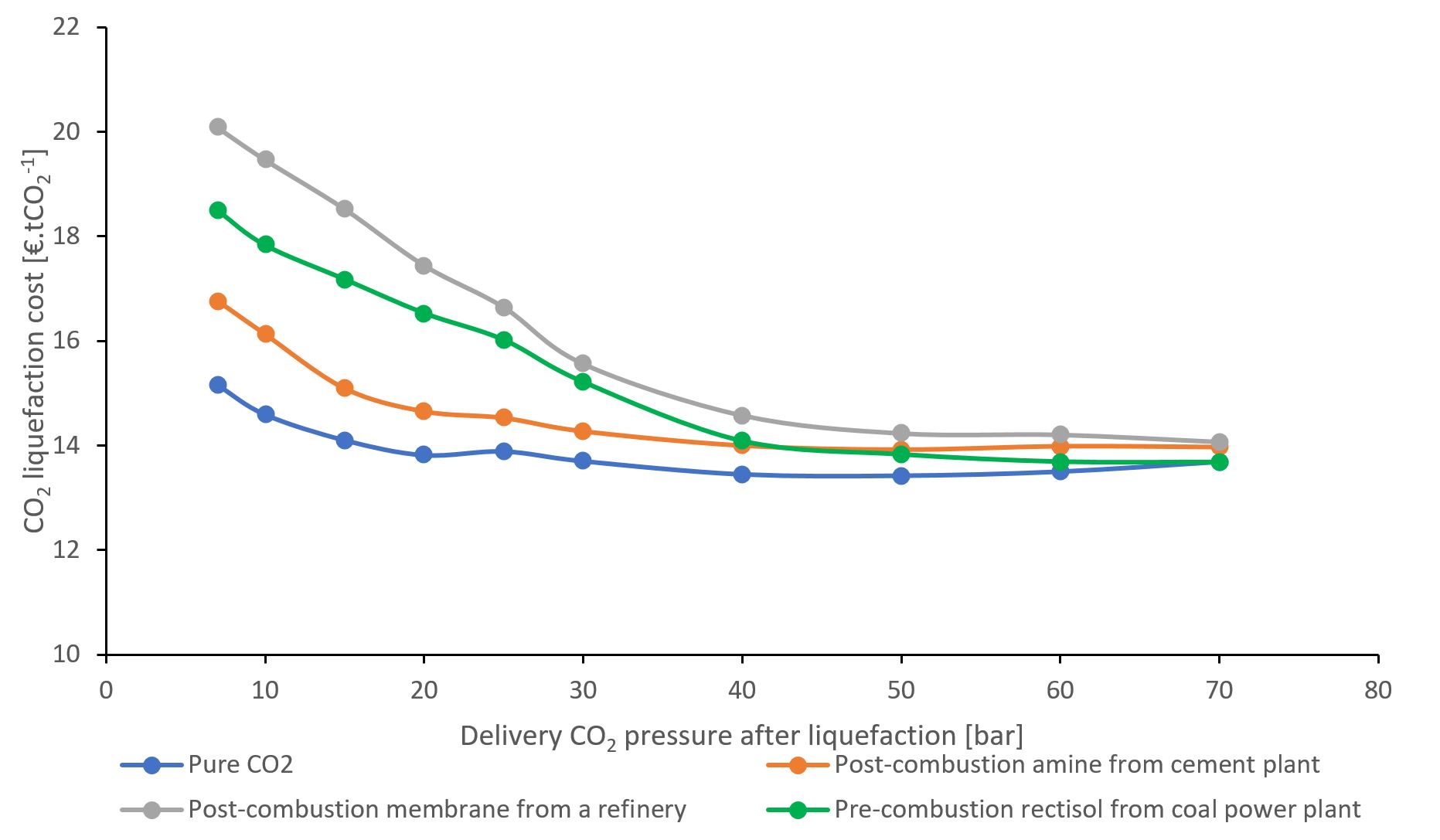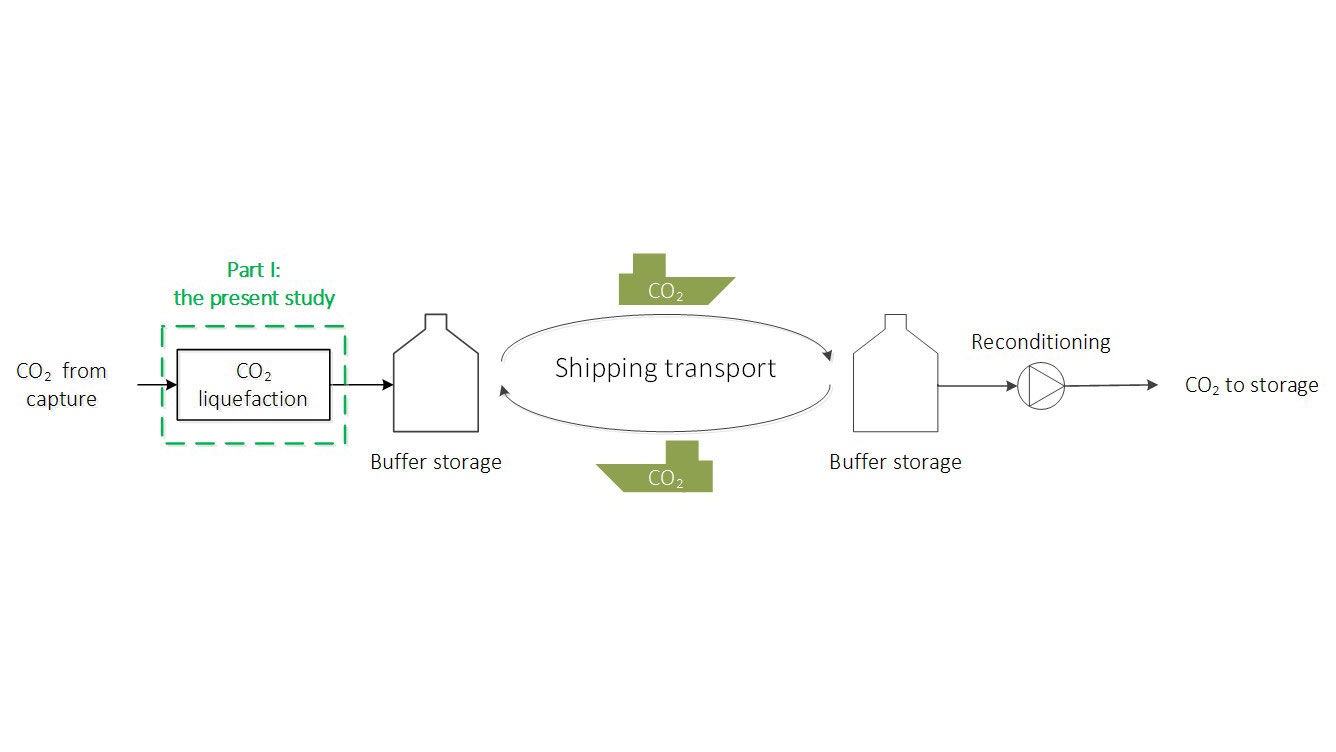Ship-based transport of CO2 is an attractive technology for early deployment of CCS. It has several advantages like cost-effectiveness for long distances and small volumes, low capital investment, flexibility, and opportunities for co-utilisation of infrastructure. As CCS chains based on ship transport are moving closer to implementation, the question of optimal transport conditions (pressure, temperature and composition) is being raised. To date, no openly public study has satisfactorily concluded on optimal transport conditions for CCS. A first step towards identifying these conditions is better understanding of the CO2 liquefaction process.
Learn more about CCS
Join our newsletter to stay updated with all the latest research results and news from NCCS: The Norwegian CCS Research Centre.
The components of the CO2 shipping chain
The CO2 shipping chain starts after the CO2 capture and lasts until storage. The chain involves liquefaction, buffer storage, loading/unloading, shipping transport and reconditioning. In practice, the CO2 could be transported under different transport conditions (temperature and pressure).

What did we previously know about optimal CO2 shipping conditions?
In the past decade, the low pressure-based transport (7 bar and -50℃) and medium pressure-based transport (15 bar and -30℃) have been the two most discussed options. For the Norwegian full-scale CCS project, initial work pointed at the 15 bar option as the best solution from the cost, safety and maturity perspective. Recently, it was indicated that in the future, lower pressure-based transport could be a better solution.
In Norwegian CCS Research Centre (NCCS), we therefore do research to identify the optimal transport conditions and provide recommendations on the best measures to cut CCS costs. As a first step toward this ambitious target, we started by focusing on the liquefaction, especially on trying to understand the impact of the targeted transport pressure and impurities on the design and cost of the process. The blog presents the results of this work performed in NCCS (Task 1) and presented in the following publication.
The CO2 liquefaction process
The CO2 liquefaction consists of a series of compression stages and cooling, through which the CO2 stream is liquefied to reach the conditions for temporary storage or transport. We considered a liquefaction process including a compression train, an impurity removal unit, a refrigeration cycle, flash tanks and other minor components.
In the compression train, the CO2 stream is compressed to the desired liquefaction pressure and water is removed by condensation to prevent hydration. The impurity removal unit will be used to remove other impurities when the delivered CO2 needs to meet a high purity requirement. The refrigeration cycle is to condense the CO2 stream.
How the delivery pressure impacts the CO2 liquefaction cost
In our study, the impact of the targeted delivery pressure on the design and cost of the liquefaction process has been investigated with an integrated techno-economic optimisation model. We looked at four cases; a case based on pure CO2 after the capture process, which corresponds to the ideal situation, and three cases considering CO2 composition obtained from the following combination of industrial application and capture technologies:
1) Amine-based post-combustion CO2 capture from a cement plant
2) Membrane-based post-combustion CO2 capture from a refinery
3) Rectisol-based pre-combustion CO2 capture from a coal power plant.
While the first case helps us understand the performances of the CO2 liquefaction process under “ideal” conditions (i.e. no impurities), the three last cases enable a good understanding of the impact of type and level of impurities on the liquefaction process design and cost.
After evaluating the technical and cost performances of the liquefaction process for 10 targeted transport pressures (ranging from 7 bar to 70 bar) for the four scenarios, we found that:
- For pure CO2, the highest liquefaction cost is obtained at 7 bar among the range considered, while a minimum lies around 40-50 bar (13% cheaper than at 7 bar). The decrease in cost is due to the significant reduction in the power requirement associated with cooling of the CO2
- For impurity cases considered, the liquefaction cost is increased significantly compared to pure CO2 (up to 34% in some cases). This increase varies from case to case, with the membrane-based case being the most affected and the amine-based case being the least. Overall, delivery pressure under 30 bar is the most heavily impacted, while a more moderate increase is observed beyond. The rise in the cost is partially caused by the loss of CO2 through purge to remove impurities that are not soluble in the CO2 This results in a reduction in the amount of CO2 delivered by the liquefaction process. Besides, the rise in cost is also linked to the higher investment cost of the liquefaction process, due to higher compression and cooling requirement.
- In the comparison of the most discussed 7 and 15 bar options, the cost is reduced by 1.05 €.tCO2-1 at the 15 bar option for pure CO2 case, while the reduction varies between 1.3 and 1.7 €.tCO2-1 depending of the impurity scenarios considered.

The effect of purity requirements
For a given impurity case, the different delivery pressures may result in different purities of the delivered CO2 after the liquefaction process. In the above analysis for the impurity scenarios, no requirement is imposed on the purity of delivered CO2. However, strong purity constraints may be imposed to the liquefaction process due to requirement down the chain (transport and/or storage). This could have a significant impact on the comparison of the different possible transport pressures. We selected one impurity case to investigate the impact of the purity requirement, with considering industrial-grade and food-grade purity requirements (≥99% and ≥99.9% purity respectively).
Learn more about CCS
Join our newsletter to stay updated with all the latest research results and news from NCCS: The Norwegian CCS Research Centre.
It turns out that potential purity requirements also have a significant impact on comparisons of the delivery pressure. For example, the cost difference between the 7 and 70 bar pressure options is significantly reduced when 99% purity requirement is met. The difference ranges between 3.2 and 4.5 €.tCO2-1 depending on the cost of impurity removal, while this difference is 6 €.tCO2-1 in the case without a purity constraint. For further details and findings, please read the full-length paper.
Next step – integrating with the rest of the chain
We are continuing the work to integrate results from CO2 liquefaction with the shipping part of the chain (buffer storage, ship transport and reconditioning), to reach our goal of identifying the optimal transport conditions for the whole CO2 shipping chain.











Comments
Dear Sir,
I am CCS researcher in Japan and I am be involved in Japan CO2 shipping demonstration.
I was infested in this contents.
So could I possibly ask you to have an opportunity to exchange the information, please?
If you have some report of CO2 shipping, could I have a copy, please?
Thank you for your cooperation.
Kind regards,
Thank you for your comment Mr Miyagawa.
Sorry for not replying before, I have just received the notification.
Good that you got in touch by e-mail and we talk after the holidays.
Best regards,
Simon